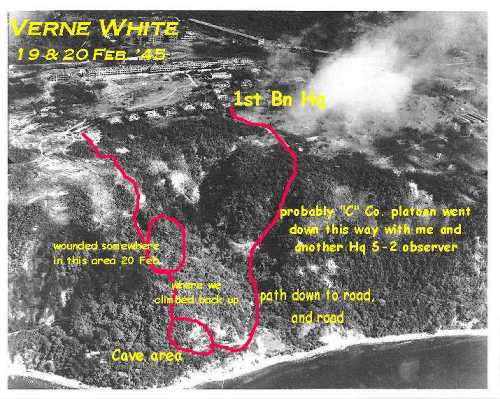|
- 3 -
That night as we were sleeping I was awakened and
cautioned to remain quiet and go to the outside porch which surrounded the main building.
This was because someone had seen Japanese infiltrators getting in position to attack. As
luck would have it I also had a bottle of captured Japanese rice wine, so it went along
with us to the porch where we laid quietly, waiting for whatever might be forthcoming.
Some grenades were thrown into the building, but
since we were all outside no harm was done. I had one finger in the barrel of the rifle
and another in the neck of the bottle to keep any dust and dirt from getting into the
critical areas. At that point it came to me that while we fought during the day and rested
during the night, the Japanese kept just the opposite schedule.
(On October 25, 1999, it was my extreme pleasure to
meet with Harry Akune who had been attached to Regimental HQ as an interpreter. We talked
of many people and experiences. During the discussion we reminded each other of the
terrible fly problem. They swarmed and lit on everything. It was impossible to eat the
food without having to brush the flies off it just as you would put it in your mouth. He
had several papers and books and the photos on the following pages have been taken from
them.)

The
route taken by the combat patrol of "C" Co., 1st Bn, on each of the mornings of
the 19th and 20th February was down the east side of Crockett Ravine to the
South Shore road, and then up towards Btry Boston, on the west side of the
ravine.
A little to the left of the center and near the
bottom of the picture you can see a short white open angled line. This is a part of the
road that the platoon was on. To the left of the intersection of the angle and against the
side of the hill is a domed-like darker spot; this is the cave opening. We came from the
right and passed across in front of the cave mouth. Where the dark shrubbery shows to the
left of the cave is where we climbed the ridge to the path that can be seen as a white
mark (a little obscured by the shrubs) above the shrub line angling off to the right from
the somewhat oval white smoke from an explosion and leading to the top.
Next morning was the fateful day for a platoon of
Company C, and for me in particular. The mission was to descend the south hillside via a
roadway down to the road which circumnavigated the main part of the island. All went well
until as we were going west on that perimeter road we came to a large cavern in the side
of the hill. It was at least 20 feet tall. The lead squad had crossed in front of it and
had fired rifle grenades into the area which contained several trucks. They followed those
with white phosphorus grenades. Suddenly from the cave three Japanese soldiers ran out
across the road and down the remainder of the hillside toward the ocean. The undergrowth
was so heavy that they quickly disappeared from sight.
A moment of panic ensued but was rapidly brought
under control by the Lieutenant. Our force was divided on each side of the cave. Getting
us back into a cohesive unit was of paramount importance. In small groups of two or three
we ran across the front of the cave while covering fire was used by one or two guys
stationed at the corners of the cave opening. A few of the platoon were wounded and some
were killed, including my friend, the other intelligence man. He felt nothing as he was
shot right in the head and killed instantly. Another was the radio man.
When we all were assembled on the other side of the
cave the decision was to climb the hill and report back to HQ. We had to climb the hill as
to cross in front of the cave to go back the way we had come would invite other
casualties. We were somewhat protected from the cave's weaponry since we rounded a small
point which put us on a more westerly side of that portion of the hill. Some of the
platoon started climbing when it was noticed that we should get the radio from the body of
our fallen comrade. I did that and began the climb. Part way up, one of the troopers from
a squad took over the task of carrying the radio. It was a difficult climb because of the
steepness of the hill and the undergrowth. Added to the arduous task was the fact that we
were all scared that the enemy was below and our backs were exposed to any fire that he
might wish to send our way. This added emphasis to the speed with which we got back to the
top.
That night was not a
pleasant one for sleep, as you might imagine.
/4
|